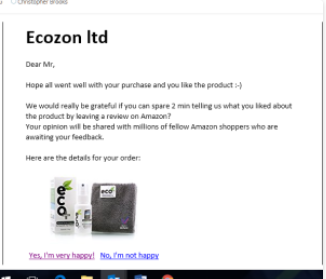“We’ve gone from being exposed to about 500 ads a day back in the 1970s to as many as 5,000 a day today,” remarked Jay Walker-Smith of Yankelovich Consumer Research. Amidst this deluge of information, one can’t help but wonder if the barrage of customer feedback requests might surpass even these numbers, given the relentless frequency with which they solicit our attention.
I once attended a CX event where one company alone claimed to have over 300 listening points! As customers, we seem to be asked at every keystroke or footstep to provide feedback for one thing or another.
Is the purpose to improve the customer experience to meet known outcomes, or to identify processes unfit for release? Will companies’ use of feedback to uncover faults enhance or impair customer perceptions?
The experience of feedback
I’ve heard it said, ‘But it’s feedback, that’s different to comms’. Organisations can’t afford to believe feedback systems are in a bubble and won’t impact the customer’s overall perception of their experience.
Our evidence, from research and from helping companies caught in this space, shows that while ‘being listened to’ is important to many customers (so much so it can be a driver of decision-making), companies still need to listen timely, measure, and execute feedback meaningfully for it to be recognised and valued by customers.
We once collated feedback survey data sets for a client for analysis to discover that two of the top five reasons for detractor scores were the quality and quantity of surveys received by customers!
Voice of the Customer (VoC) designs frequently overlook brand experience. The voice of the customer should align with brand value and visual identity, adhering to brand experience standards. However, platform limitations often restrict flexibility to minor changes like logos or colours.
I saw an example recently where the company’s feedback button had been launched on top of the customer ‘contact us’ button used for sales. Brand should be at the table when it comes to VoC feedback design as well as being grateful recipients of the insights.
Is quality sacrificed for quantity?

When I walk through an airport, I’m asked to feed back how the experience was at security, passport control, at Starbucks, WHSmith’s, the loos etc. – it seems everywhere. And any bored 5-year walking to the gate ahead of me gets to whack the same set of buttons as me. I chose not to tap because of the flawed value, even though I had an experience I wanted to feedback. How useful is that data exchange?
If this was a polling station, or online questionnaire, the child’s feedback would be recorded as a spoil. But not here – every ‘whack’ and ‘whacker’ is equal. Worryingly there will be execs analysing this data, making investment choices for the airport experience.
Doubling up. Dumbing down.
Serving online feedback might lead to their downfall. A recent personal experience illustrates this. After buying a screen cleaner for less than £6 on Amazon Prime, I received two feedback requests.

First, Amazon bombarded me with three questions in one message, a clumsy approach. The questions were irrelevant, focusing on an unnamed seller instead of Amazon itself, where I made the purchase.
Then, the actual seller contacted me, asking for more feedback. They wanted ‘2 min’ of my time, twice the duration of my purchase. Their request referenced ‘millions of shoppers awaiting my review’, a ludicrous notion.

And then I look at the choices for feedback which feel rather loaded to me. I asked my 11-year-old son whether he was ‘very happy with the screen clean’. He looked at me like I was mad. I didn’t pursue it.
Whose benefit is it for after all?
So, whose benefit does this incessant feedback loop truly serve?
While the primary purpose of customer feedback should be to enhance the customer experience, the focus often shifts towards amassing volume for marketing purposes, diluting its efficacy in the process. In this pursuit, the true essence of feedback, as a means of insight collection, is undermined.
Shortly afterwards, we bought a £180 keyboard for our other son’s birthday. That’s a significant purchase to us, and emotively means something as I want my son’s face to be full of joy on his big day. So how it was presented online, the reviews, the packaging, the delivery and how it performed really mattered. However, because we get feedback requests for everything we buy on Amazon, I can’t be bothered to feedback on anything from them anymore.
Listening but not hearing what really matters
Digital capability has enabled the popularity of this continuous feedback obsession. Where an interaction occurs (either commercial or service-based), there’s an opportunity to capture feedback. Sometimes it feels appropriate, other times it’s as unwelcome as a power cut. The driver is the need for vendors’ platforms to consume vast lakes of data to ensure analytics are substantial. And some price per response are aware of this dependency too, although most have moved beyond this pricing model now.
What happens when the digital data collection touchpoint is absent?
Silence!
In my recent visit to my local 3 shop, with five devices under their service, I discovered some of my devices had ended their contracts without any notice, leaving me overpaying for months. Despite the service rep’s efforts, retrieving information was challenging due to system limitations. We resorted to pen and paper to calculate potential savings of £90 per month. Though I transitioned from detractor to promoter, the lack of a transaction prevented me from giving feedback on critical issues like app integration and CRM transparency. Or most importantly (in my mind) the patience and brilliance of the service rep. He turned it around. That was the moment that mattered most in all the time I’ve had 3 contracts, and 3 missed it.
This experience underscores how organisations miss crucial moments when feedback systems are tied to technology capabilities.
This highlights the challenge VoC managers face in appropriately gathering feedback from the right customers when it matters most to them, not the organisation.
The customer feedback asset journey map is intriguing but ironically often overlooked.
In navigating the intricacies of customer feedback management, it’s imperative to prioritise quality over quantity, ensuring that feedback serves its intended purpose—to enrich the customer experience. Failure to do so risks not only diminishing returns but also alienating customers, potentially driving them away altogether.
More from Lexden
If you’d like to receive more articles on driving more profitable Customer Experience, please sign up for our free monthly newsletter.
Lexden helps deliver effective customer experience insight, strategy, content and creative activation for clients seeking sustainable profit from customer experience.



